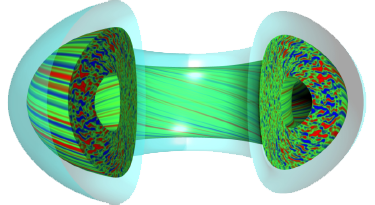Present and future fusion devices have to analyse a huge amount of measurements coming from many diagnostic systems. The information obtained from these measurements are and will be used for machine control and safety as well as physics studies. Integrated Data Analysis (IDA) in the framework of Bayesian probability theory provides a concept to analyse a coherent combination of measured data...
The development of Synthetic Diagnostics for ITER is essential to optimise the design of the diagnostics, to develop the necessary control algorithms utilising them, and to perform specific physics studies, including integrated data analysis, for each phase of the ITER Research Plan. The work will involve the standardised approach of the Integrated and Modelling & Analysis Suite (IMAS) with...
The electron cyclotron emission (ECE) diagnostic is a well-established and robust instrument for the localized measurement of the electron temperature $T_\mathrm{e}$. It measures the microwave spectrum radiated by the plasma. The measured microwave intensity can be calibrated to directly deliver $T_\mathrm{e}$. The location of the measurement is determined by finding the position on the line...
Integrated Data Analysis (IDA) allows to infer plasma quantities like electron density using heterogeneous data sources. Essential is forward modelling with physically reasonable models to the data space for probabilistic evaluation. The paper presents the progress in extending the set of AUG's diagnostics for electron density profile inference by a microwave reflectometry system.
For swept...
This paper summarizes the development of software tools to detect the approach to the L-H transition in ITER PFPO (Pre-Fusion Power Operation) scenarios. In particular, it describes to what extent the physical phenomena associated with the L-H transition can be characterized using the set of diagnostics available in PFPO. The H-mode is associated with the development of an edge transport...
Previous analyses show that various Alfven Eigenmodes (AEs) can be partially unstable in ITER: energetic particles (EPs), such as fusion-born alpha-particles or neutral beam ions are energetic enough to resonantly interact with these weakly damped plasma waves. Due to the sensitivity of the AEs’ properties on the background kinetic profiles, an automated analysis method is required to study...
WEST (tungsten –W– Experimental Steady-state Tokamak) is a device specialized for long pulse operation in a tungsten environment. Its main purpose is to study the plasma-wall interactions in a metallic environment and to be a test bed for ITER plasma facing components [1-3]. Between 40 and 50 diagnostics help to characterize WEST plasmas. The acquisition systems produce a large heterogeneous...
While experiments on fusion plasmas produce high-dimensional data time series with
ever increasing magnitude and velocity, turn-around times for analysis of this
data have not kept up. For example, many data analysis tasks are often performed
in a manual, ad-hoc manner some time after an experiment. In this article we
introduce the DELTA framework that facilitates near real-time...
“Fusion Cloud” is a new concept to realize an interdisciplinary data analysis platform primarily based on fusion experiments and numerical modeling data across academic institutions and universities in Japan. Not only for the next-generation fusion experiment’s diagnostics and operations, such as in ITER and JT-60SA, but also for enabling the fusion demo reactor designs, some standard...
TOWARDS IMPLEMENTING THE FAIR4FUSION OPEN DATA BLUEPRINT
MICHAL K. OWSIAK
Poznan Supercomputing and Networking Center – Institute of Bioorganic Chemistry, PAS
Poznan, Poland
Email: michal.owsiak@man.poznan.pl
STASINOS KONSTANTOPOULOS
Institute of Informatics and Telecommunications - National Centre for Scientific Research "Demokritos"
Email: konstant@iit.demokritos.gr
Aghia...
The European fusion research activities have over the last decades generated a vast and varied set of data. Even if a survey of the generated data is restricted to EUROFusion, the implementation of the fusion research programme under the EU Horizon 2020 framework programme, the volume and diversity of the data that need to be catalogued and reviewed make the task of organizing and making the...
DATA-DRIVEN DISCOVERY APPROACH TO TACKLE TURBULENCE IN FUSION PLASMA
Salazar Luigui
University of Lorraine - CNRS
54000 Nancy, France
CEA, IRFM
13108 Saint Paul lez Durance, France
Email: luigui.salazar@cea.fr
Stéphane HEURAUX
University of Lorraine - CNRS
54000 Nancy, France
Roland SABOT
CEA, IRFM
13108 Saint Paul lez Durance, France
Abstract
The identification of turbulence sources...
A suggestion tool for experimental data analysis and tokamak proposal validation was developed using machine learning methods. The bidirectional LSTM neural network model was used, and experimental data from Experimental Advanced Superconducting Tokamak (EAST) campaign 2010-2020 discharges were used as the model training data set. Compared to our previous works (Chenguang Wan et al 2021 Nucl....
With a growing emphasis on open data, and a drive to improve the interoperability of fusion data, a holistic and standardised approach to data provenance is required. Modern and emerging research methods that handle large data sets will require that metadata, including provenance, can be handled similarly and programmatically, regardless of their source. The FAIR data principles outline...
"Data provenance" is critical to establishing repeatable and integrated modeling and analysis workflow (e.g. IMAS). Most of the physical modules in the workflow are published in source code. The configuration parameters and compilation environment during the module construction process can affect their output. The provenance information generated by traditional workflow management tools only...
MAST data has been “open” following UK Research Institute guidelines since the end of its 36 month embargo period, with all data now available. This data is available on request through a web interface and is built around maintaining control over who can access the data and for what purpose, in order to provide support to users making use of the data and ensuring it is used for valid research...

